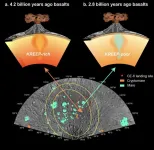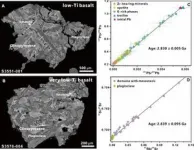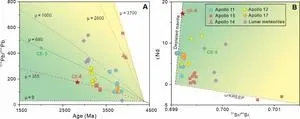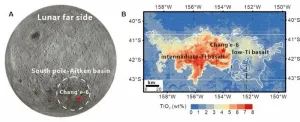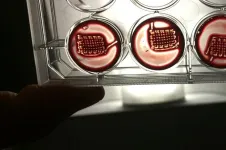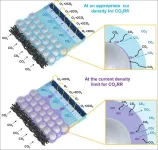Chang’e-6 basalts offer insights on lunar farside volcanism
2024-11-15
(Press-News.org)
Basalt samples returned by the Chang’e-6 mission have revealed volcanic events on the lunar farside at 2.8 billion years ago (Ga) and 4.2 Ga, according to research conducted by Prof. LI Qiuli’s lab at the Institute of Geology and Geophysics of the Chinese Academy of Sciences. This work was recently published in Nature.
“Unraveling the volcanic history of the lunar farside is crucial for understanding the hemispheric dichotomy of the Moon,” said Prof. LI.
The asymmetry between the Moon’s nearside and farside—encompassing differences in basalt distribution, topography, crustal thickness, and thorium (Th) concentration—has long been a mystery. However, China’s Chang’e-6 mission—the first to return samples from the lunar farside—has created a unique opportunity to explore volcanic activity in this hemisphere, with the 1,935.3 g lunar soil sample it retrieved.
Led by Prof. LI, postdoctoral researcher ZHANG Qian conducted systematic radioisotope dating on 108 basalt fragments from this sample. Of these, 107 fragments revealed a consistent formation age of 2807 ± 3 million years ago (Ma), indicating the eruption age of local basalts at the Chang’e-6 landing site. Notably, this 2.8 Ga volcanic episode has not been observed in nearside samples.
The remaining fragment, of high-aluminum basalt and dating to 4203 ± 4 Ma, is thought to have originated from a cryptomare region south of the landing site. It is the oldest lunar basalt sample yet returned whose age has been precisely determined.
These data indicate that volcanic activity on the lunar farside persisted for at least 1.4 billion years, from 4.2 Ga to 2.8 Ga. Initial lead isotope analysis suggests that these basalts derive from distinct mantle sources: The 4.2 Ga basalt came from a KREEP-rich source, i.e., one with abundant potassium (K), rare earth elements (REE), and phosphorous (P), while the 2.8 Ga basalt came from a KREEP-poor source.
The close alignment between the 2.8 Ga basalt age and crater-counting estimates suggests that the cratering chronology model, established based on nearside observations, is also applicable to the lunar farside. The radioisotope ages of the Chang’e-6 basalts provide an essential calibration point for refining lunar crater-counting chronology, thus enhancing its accuracy, according to Prof. LI.
This research was conducted in collaboration with the National Astronomical Observatories, with samples provided by the China National Space Administration. Funding was provided by the National Natural Science Foundation of China, the Strategic Priority Research Program (Category B) of the Chinese Academy of Sciences, and the Key Research Program of the Institute of Geology and Geophysics, Chinese Academy of Sciences.
END
ELSE PRESS RELEASES FROM THIS DATE:
2024-11-15
The Moon has a global dichotomy, with its near and far sides having different geomorphology, topography, chemical composition, crustal thickness, and evidence of volcanism.
To better understand this dichotomy, Professor XU Yigang’s team from the Guangzhou Institute of Geochemistry of the Chinese Academy of Sciences investigated lunar soil samples from the far side South Pole-Aitken (SPA) Basin of the Moon returned by the Chang’e-6 mission.
Their work was published in Science on Nov. 15.
“The samples returned by Chang’e-6 provide a best opportunity to investigate the lunar global dichotomy,” said Professor ...
2024-11-15
Dietary zinc deficiency promotes lung infection by Acinetobacter baumannii bacteria — a leading cause of ventilator-associated pneumonia, according to a new study published Nov. 15 in the journal Nature Microbiology.
A Vanderbilt University Medical Center-led team of researchers discovered an unexpected link between the pro-inflammatory cytokine interleukin-13 (IL-13) and A. baumannii lung infection, and they demonstrated that blocking IL-13 prevented infection-associated death in an animal model.
The findings suggest that anti-IL-13 antibodies, which are FDA-approved for use in humans, may protect against bacterial pneumonia in patients with zinc deficiency.
“To ...
2024-11-15
In what could one day become a new treatment for epilepsy, researchers at UC San Francisco, UC Santa Cruz and UC Berkeley have used pulses of light to prevent seizure-like activity in neurons.
The researchers used brain tissue that had been removed from epilepsy patients as part of their treatment.
Eventually, they hope the technique will replace surgery to remove the brain tissue where seizures originate, providing a less invasive option for patients whose symptoms cannot be controlled with medication.
The ...
2024-11-15
Children born to mothers who take antiseizure medications to manage seizures and psychiatric conditions during pregnancy may face increased risks of neurodevelopmental conditions, according to new data from researchers at Drexel’s Dornsife School of Public Health.
The current work -- using data from more than three million children from the United Kingdom and Sweden, including 17,495 who were exposed to antiseizure medications during pregnancy -- found that children exposed to the antiseizure drug lamotrigine ...
2024-11-15
Bottom Line: In patients with unresectable, locally advanced esophageal cancer, the triple combination of radiation, chemotherapy, and immunotherapy made tumors more amenable to surgery, which was associated with significantly improved outcomes.
Journal in Which the Study was Published: Clinical Cancer Research, a journal of the American Association for Cancer Research.
Background: “Curative resection unequivocally serves as the cornerstone for treating resectable esophageal squamous cell carcinoma (ESCC); ...
2024-11-15
Scientists have created a new ‘biocooperative’ material based on blood, which has shown to successfully repair bones, paving the way for personalised regenerative blood products that could be used as effective therapies to treat injury and disease.
Researchers from the Schools of Pharmacy and Chemical Engineering at the University of Nottingham have used peptide molecules that can guide key processes taking place during the natural healing of tissues to create living materials that enhance tissue regeneration. The research published today in Advanced ...
2024-11-15
The New Phytologist Foundation is delighted to announce that Professor Maarja Öpik will take up the position of Editor-in-Chief of New Phytologist from January 2025 for an initial term of five years.
Maarja has served as a member of New Phytologist's editorial board since 2013 and is Professor of Molecular Ecology and Director of the Institute of Ecology and Earth Sciences at the Faculty of Science and Technology at the University of Tartu, Estonia.
Maarja’s research addresses the interactions between plants and mycorrhizal fungi, with ...
2024-11-15
Mountain lions in greater Los Angeles are proactively shifting their activity to avoid interacting with cyclists, hikers, joggers and other recreationists, finds a study from the University of California, Davis, Cal Poly Pomona and the National Park Service.
The study, published Nov. 15 in the journal Biological Conservation, found that mountain lions living in areas with higher levels of human recreation were more nocturnal than lions in more remote regions who were more active at dawn and dusk. The authors said their findings offer a hopeful example of human-wildlife coexistence amid a large, dense human population.
“People are increasingly enjoying recreating ...
2024-11-15
In May, the WHO raised the alarm over the rise in incidence of sexually transmitted illnesses (STIs) in many regions of the world, currently running at more than a million new cases per day. Among high-income countries, the US has one of the highest prevalences of STIs, and this problem is getting worse. For example, the incidence of chlamydia has more than doubled since 2000, while gonorrhea increased by 40% and syphilis by 400%. The highest prevalence is among young adults between 20 and 34 years of age.
Over ...
2024-11-15
The research team led by Dr. Hyung-Suk Oh and Dr. Woong Hee Lee at the Clean Energy Research Center at Korea Institute of Science and Technology (KIST, President Sang-Rok Oh) has developed a silver-silica composite catalyst capable of reversible local pH control through a silica-hydroxide cycle, inspired by Earth’s natural cycles. This research draws inspiration from the carbonate-silicate cycle, known as the Earth’s inorganic carbon cycle, where carbon dioxide (CO₂) maintains balance. CO₂ is removed from ...
LAST 30 PRESS RELEASES:
[Press-News.org] Chang’e-6 basalts offer insights on lunar farside volcanism
